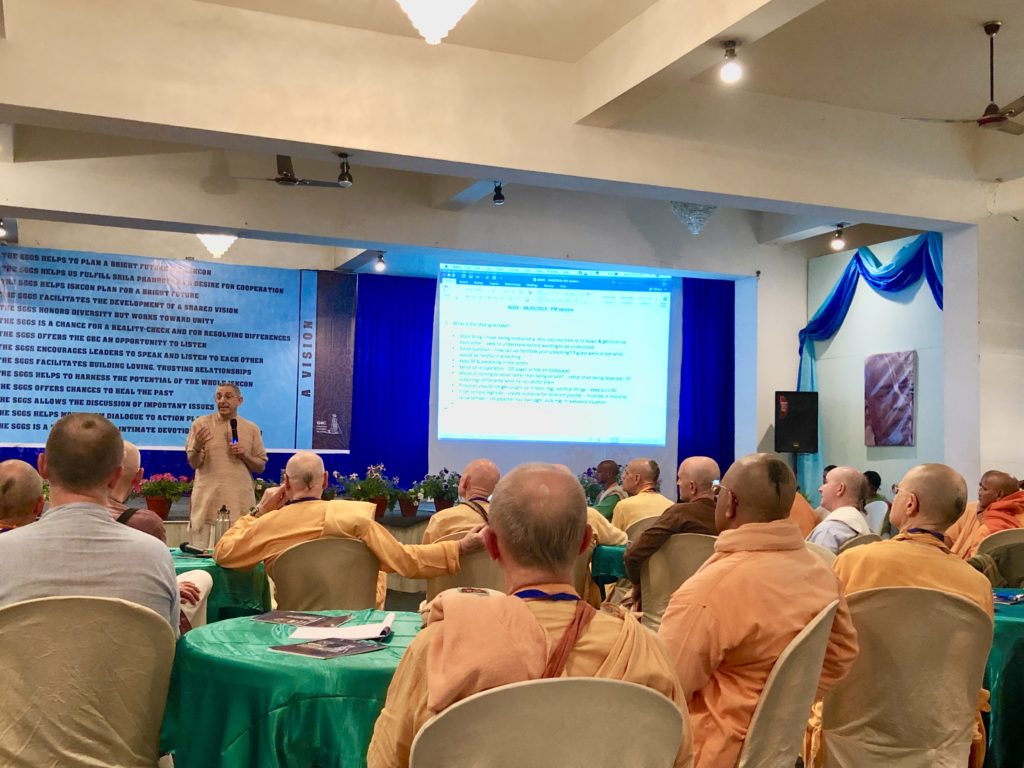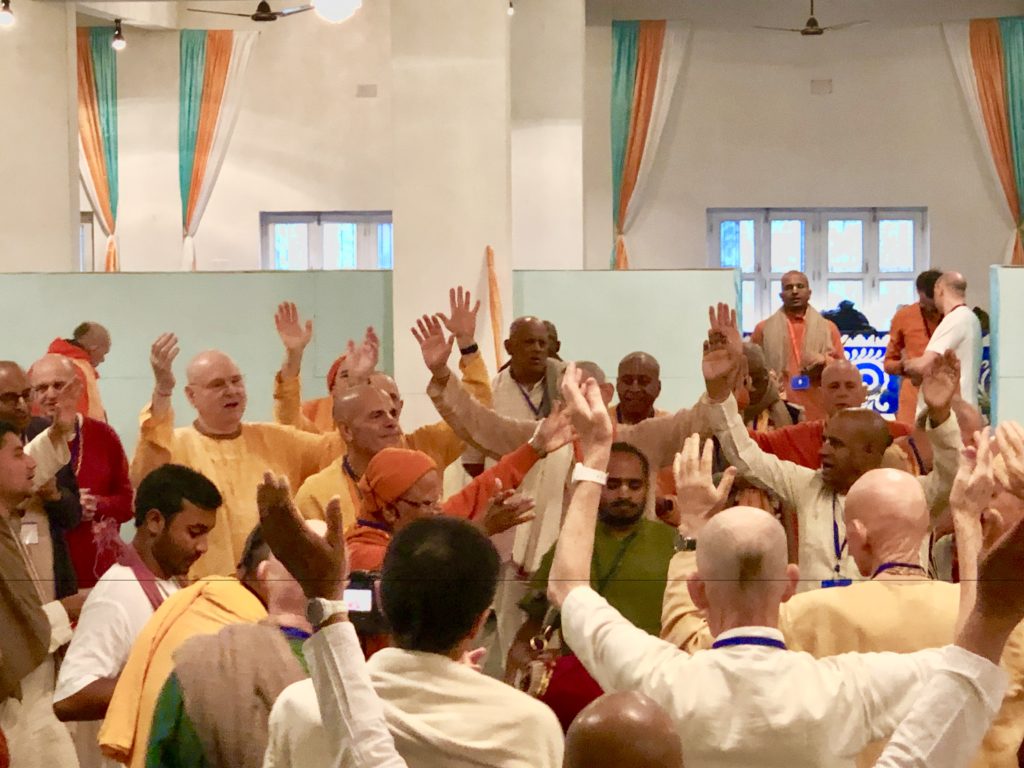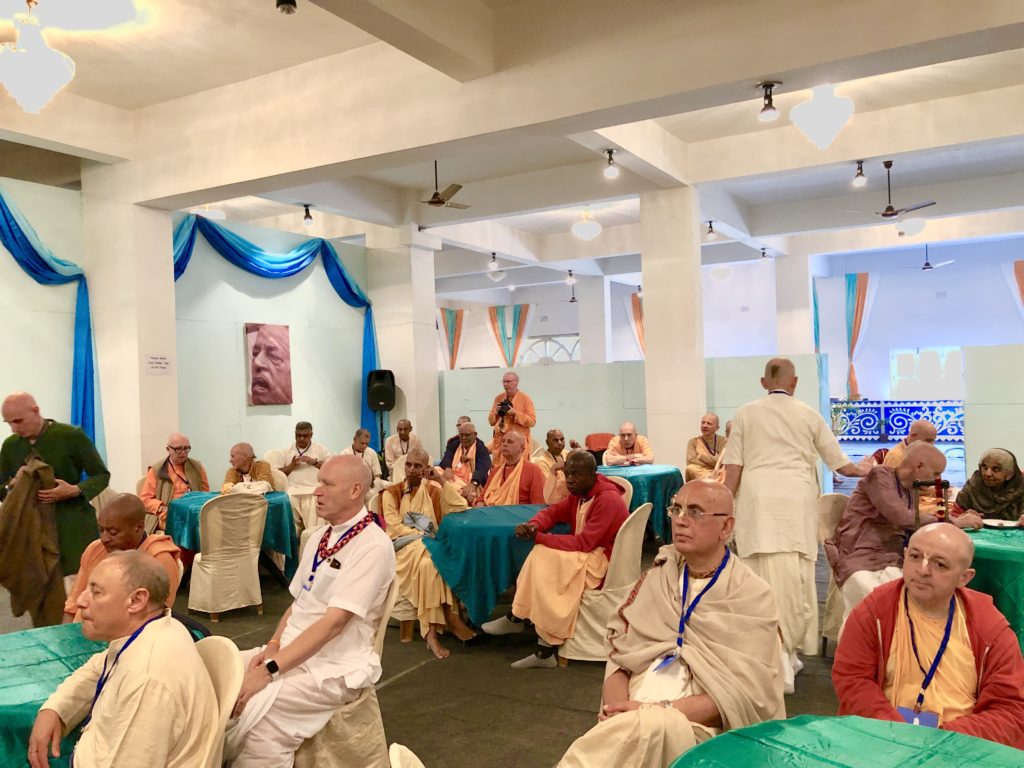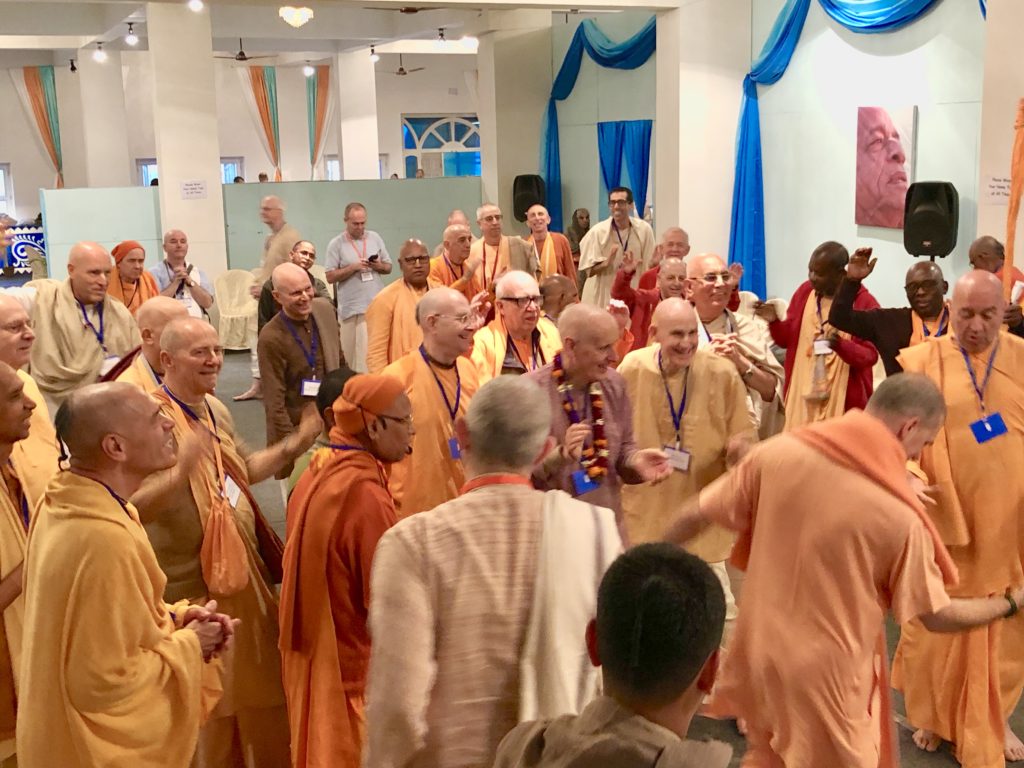
Iskcon Leicester: City Mayor Sir Peter Soulsby joins ISKCON Leicester President Pradyumna Dasa to officially open Avanti Fields, Leicester’s first Hindu all-through school
To read the complete article please click here: https://goo.gl/HE2bw9
Websites from the ISKCON Universe

Iskcon Leicester: City Mayor Sir Peter Soulsby joins ISKCON Leicester President Pradyumna Dasa to officially open Avanti Fields, Leicester’s first Hindu all-through school
To read the complete article please click here: https://goo.gl/HE2bw9

Pastimes of Srila Prabhupada (video)
By Ramesvara Prabhu on 4th Mar 2019 at ISKCON Juhu Mumbai.
 The International Society For Krishna Consciousness (ISKCON) has a Temple in Agartala. The presiding deities are Sri Sri Jagannatha, Baladeva, Subhadra. There is a book shop and a Prasadam stall in front of the temple. Behind the temple is Govindas restaurant.
The International Society For Krishna Consciousness (ISKCON) has a Temple in Agartala. The presiding deities are Sri Sri Jagannatha, Baladeva, Subhadra. There is a book shop and a Prasadam stall in front of the temple. Behind the temple is Govindas restaurant. 
Lord Ramacandra stands holding a bow and arrow in the center of the painting surrounded by a rocky landscape. Laksmaṇ stands behind Him and also holds a bow and arrow. Like Lord Ramacandra, He is effulgent. Both Lord Ramacandra and Laksman wear wooden sandals.
Also standing behind Lord Ramacandra are Hanuman, Angada, Arunda, Nila and Samrambha. They all hold maces in their hands and wear golden crowns.
In front of Lord Ramacandra stands King Sugriva holding an umbrella in his left hand and a mace in his right hand. He is followed by Nala, Vanara, Durvinda and Rambha who all hold maces.
[ Watercolor on paper. Early 1800’s ]
 After preaching in Maharashtra’s Bhandara district the All-India Padayatra entered Nagpur city at Suryanagar on February 7. Walking for a further 7km, we reached the ISKCON Radha-Gopinath temple in Empress City, where the devotees welcomed Sri Sri Nitai-Gaurasundar with garlands and a grand sankirtan. The matajis then washed the hooves of our oxen, showered flowers on them and performed arati of Their Lordships.
After preaching in Maharashtra’s Bhandara district the All-India Padayatra entered Nagpur city at Suryanagar on February 7. Walking for a further 7km, we reached the ISKCON Radha-Gopinath temple in Empress City, where the devotees welcomed Sri Sri Nitai-Gaurasundar with garlands and a grand sankirtan. The matajis then washed the hooves of our oxen, showered flowers on them and performed arati of Their Lordships. 
Praying to become an instrument for saving souls (video)
Srimad Bhagavatam Class by Ramesvara Prabhu on 5th Mar 2019 at ISKCON...
 Every Purnima, sixty flags will be offered to the Deities and two raised every day in the names of their sponsors. The flags will then be shipped to the sponsors as prasadam for their seva. This transcendental monthly festival will continue into the future for as long as the TOVP stands and will become a tradition for future generations of devotees.
Every Purnima, sixty flags will be offered to the Deities and two raised every day in the names of their sponsors. The flags will then be shipped to the sponsors as prasadam for their seva. This transcendental monthly festival will continue into the future for as long as the TOVP stands and will become a tradition for future generations of devotees.  Iskcon Mayapur: Since Sri Sri Panca-tattva were installed in the Sri Mayapur Candrodaya Mandir in 2004, every 5 years They have been worshipped by an elaborate and ecstatic Maha Abhiseka. This year, 2019, was the 15th installation anniversary of Sri Sri Panca-tattva and the largest Maha Abhiseka yet.
Iskcon Mayapur: Since Sri Sri Panca-tattva were installed in the Sri Mayapur Candrodaya Mandir in 2004, every 5 years They have been worshipped by an elaborate and ecstatic Maha Abhiseka. This year, 2019, was the 15th installation anniversary of Sri Sri Panca-tattva and the largest Maha Abhiseka yet.  By Yugala Kishor Gour dasa
By Yugala Kishor Gour dasa On the 10th of March it will be exactly 60 years ago, 10th of March 1959, that the MS Jaladuta was launched at its shipbuilding yard in Lubeck Germany. It is this vessel that brought Srila Prabhupada from Calcutta, via Boston, to New York on a journey that started on the 13th August 1965, in what became an astonishing journey and also the beginning of the International Society for Krishna Consciousness. This launch was organised by the Lubecker-Flenderwerke AG yard in Northern Germany at the completion of the ship. This event is standard in the shipbuilding industry and is likened to a christening name giving ceremony. The vessel receives its name and blessings from all present guests for its future journeys. An interesting fact is that Scindia named the majority of their vessels starting with Jala, Jalakrishna, Jalagopal, Jalakanta etc. The procedure is that the yard invites a prominent figure to speak the name of the vessel while simultaneously breaking a bottle of champagne over the bow. In this case the shipbuilders invited members of the board of Scindia, and instead of a bottle of alcohol, a blessed coconut was used to inaugurate the name giving ceremony. Continue reading "Jaladuta
→ Dandavats"
Today is the second day of Gaura Purnima festival. More and more devotees have started arriving at Mayapur. Today is also the second day of Kirtan Mela and also of The Sanga of GBCs, Gurus and Sanyasis (SGGS). 100 of the most senior devotees have gathered and are discussing different preaching activities in ISKCON. For […]
The post Gaura Purnima Festival: Day 2 appeared first on Mayapur.com.
 Radha Mohan das: Please view my latest Youtube presentation, entitled “Understanding the Multidimensional Universe of the Vedas”.
Radha Mohan das: Please view my latest Youtube presentation, entitled “Understanding the Multidimensional Universe of the Vedas”. [Bhagavatam class at ISKCON, New Govardhan, Murwillumbah, Australia]
Podcast
Podcast Summary
The post When time becomes unfavorable, don’t become unfavorable to Krishna appeared first on The Spiritual Scientist.
Answer Podcast
The post How do we create our world by our words? appeared first on The Spiritual Scientist.
Official Opening of Krishna’s Castle, in the City of London Representatives from 10 banks and businesses attended the official opening of Krishna’s Castle on the 1st March 2019.Since 14 months Krishna’s Castle, situated in the heart of the banking world, has been a hive of devotional service. We need about 10 volunteers daily and half of them are bankers, come to do their Corporate Social Responsibly.One definition :The emerging concept of Corporate Social Responsibility (CSR) goes beyond charity and requires the company to act beyond its legal obligations and to integrated social, environmental and ethical concerns into company’s business process.
All this comes under Agnatha Sukrti. Srila Prabhupada: “The beginning of contact with Krishna Consciousness is the beginning of good fortune. That some people may come and others may not, this is also due to association. Suppose a man accidentally comes in contact with our society and gives some service willingly or unwillingly, that is the beginning of his fortunate life.”
Daily there are over 2,000 healthy plates of Prasad to be cooked, pots need to be washed , including the biggest pot in the western world, veg chopped , pakoras and popadoms cooked, and Prasad distributed.
Second Group of Volunteers:Work Away is a scheme where employers offer accommodation and food to young people in return for work. We have facilities for 10 young people in the Castle.Young people are queuing up from around the world for a chance to live in the City of London for a week or so ,and engage in meaningful activities.
Your servantParasuram Das





Srila Prabhupada jokes about bankers.Indian (1): So if about the bankers, if you permit me, I’ll give you another interesting story. There was a man who was very ill in America, and he had a heart trouble. In fact he had no heart, I would say. So, you know, they can replace the hearts nowadays. He went to a hospital, and the doctor offered him, “Here are three hearts. Which one would you like? One is of the general, the other is of a big businessman, and the third is of a banker. What would you like?” So he thought, “Let me have the heart of a…”Prabhupāda: Banker.Indian (1): “…banker.” [laughter] So the doctor said, “Why do you want to have the heart of a banker?” He thought, “Because I’m sure it has never been used.” [laughter]Prabhupāda: [laughing] I’ll recite another very nice story… [break]Indian (2): [Hindi—about opening a branch of the bank]Indian (3): [Hindi]Indian (1): There seem to be little misunderstanding, not that we are short of any space or any accommodation or anything for which we can’t open, but there’s a little technical thing that bank license does not permit, and we are immediately taking or for amending the license, and as soon as it is, we’ll start. We have no problem of this.Gurudāsa: Prabhupāda, did you want to tell another story?Prabhupāda: Yes. [laughter]Indian (1): But I had only two. I won’t be able to add.Prabhupāda: [laughter] The story is that one poor man was informed by his friend that “Money draws money.” That’s a fact. If you have got money, you can draw money. So he went to the bank, and the cashier was counting huge amount of money, and he threw his coin on the cash…, [laughs] and he was waiting = “When the whole money will come to me?” Then the cashier saw this man is standing = “What is it? Why you are standing?” “Sir, I heard that money draws money, so I had one coin. I have dropped with your money. I am waiting when it will come to me.” So he said, “No, no. The fact is that = money draws. Now my money has drawn your money.” [laughter] So… [Hindi]Indian (1): Perhaps it is in the Bible that “Those who have shall be given more. Those who have not shall be taken of what they have already.” I don’t whether it’s right or not, but more money draws the lesser money.Prabhupāda: Yes. [Hindi]April 6, 1976 Vrindavan.
Shiva-ratri occurs every lunar month on the 13th or 14th day of the dark half of the moon phase. Once every year during the month of Phalgun, a Maha Shiva-ratri occurs. This Maha Shiva-ratri day is considered to be the day when Lord Shiva married Parvati and it is celebrated elaborately by devotees of Lord […]
The post Honoring the Foremost Vaishnava-Siva-Ratri! appeared first on Mayapur.com.

Importance of historical events (video)
Srimad Bhagavatam (SB 9.15.16-24) by HH Bhakti Charu Swami in Iskcon Mayapur.
 By Parasuram dasa
By Parasuram dasa At the official opening of Krishna's Castle in the City of London on March 1st 2019, representatives from 10 banks and businesses were in attendance. Since 14 months Krishna's Castle, situated in the heart of the banking world, has been a hive of devotional service. We need about 10 volunteers daily and half of them are bankers who come to do their Corporate Social Responsibly. Continue reading "Para-upakara and The Bankers
→ Dandavats"

How I Came To Krishna Consciousness - Bhakta Rex (China) (6 min. video)
Srila Prabhupada: Fate can be changed by Krishna consciousness. Krishna says, “I shall give you protection from all the resultant action of your sinful life.” That is fate changed. When you surrender to Krishna, He takes charge of squaring up all your sinful activities and their reaction. Surrender to Krishna; then your fate is changed. Delhi, November 28, 1975.

Kirtan Mela 2019 Mayapur Adhivas (Album of photos)
May the chanting begin. The exciting day before Kirtan Mela.
Find them...
 Iskcon Mayapur: Shiva-ratri occurs every lunar month on the 13th or 14th day of the dark half of the moon phase. Once every year during the month of Phalgun, a Maha Shiva-ratri occurs. This Maha Shiva-ratri day is considered to be the day when Lord Shiva married Parvati and it is celebrated elaborately by devotees of Lord Shiva.
Iskcon Mayapur: Shiva-ratri occurs every lunar month on the 13th or 14th day of the dark half of the moon phase. Once every year during the month of Phalgun, a Maha Shiva-ratri occurs. This Maha Shiva-ratri day is considered to be the day when Lord Shiva married Parvati and it is celebrated elaborately by devotees of Lord Shiva. Kirtan Mela – festival of chanting the holy names of the Lord begins today. In a colorful Adhivas ceremony, worship was offered to the musical instruments and prayers offered for success of festival. HH Loknath Swami Maharaj led the first kirtan after Adhivas. Kirtan Mela : Day-1 Schedule: “I firmly believe that simply chanting the […]
The post Kirtan Mela begins today! appeared first on Mayapur.com.
Back in October, 2018 we announced the launch of the TOVP Victory Flag Campaign wherein devotees can sponsor the raising of the daily TOVP Victory Flags onto the temple domes. The response has been very good and the TOVP management has now decided to start a monthly Flag Festival to continue into perpetuity as long as the temple stands.
On February 2nd the first Flag Festival was officially launched during the grand inauguration ceremony of the 2019 Gaura Purnima Festival, with sixty flags being offered to the Deities for Their blessings and auspiciousness. Two flags were taken in procession around the Deities and to the TOVP office carried by Ambarisa and Braja Vilasa prabhus, and then hoisted onto the Main and Nrsimha domes of the temple.
Every Purnima, sixty flags will be offered to the Deities and two raised every day in the names of their sponsors. The flags will then be shipped to the sponsors as prasadam for their seva. This transcendental monthly festival will continue into the future for as long as the TOVP stands and will become a tradition for future generations of devotees.
To find out more about how to sponsor a daily Victory Flag, please visit the TOVP website at this address:
https://tovp.org/fundraising/tovp-daily-victory-flag-sponsorship-an-ideal-kartik-seva/
Visit us at: www.tovp.org
Follow us at: www.facebook.com/tovp.mayapur
Watch us at: www.youtube.com/user/tovpinfo
Phone App at: http://tovp.org/news/announcements/new-tovp-phone-app-goes-live/
Mailing List at: https://goo.gl/forms/ojJ2WcUUuqWh8bXt1
Support us at: www.tovp.org/donate/seva-opportunities
The post TOVP Monthly Flag Festival Launched appeared first on Temple of the Vedic Planetarium.

Iskcon leaders meet in Mayapur (Album of photos)
The Sanga of GBCs, Gurus and Sannyasis (SGGS) began yesterday in Mayapur. 100 of the most senior devotees have gathered and are discussing all types of preaching activities in Srila Prabhupada’s ISKCON.
 Our deity of Sri Gopisvara Mahadeva at our ashram today, Siva-ratri.
Our deity of Sri Gopisvara Mahadeva at our ashram today, Siva-ratri.
In his Sankalpa-kalpadruma (103) Srila Visvanatha Cakravarti Thakura prays:
vrndavanavani-pate jaya soma soma-
maule sanandana-sanatana-naradedya
gopisvara vraja-vilasi-yuganghri-padme
prema prayaccha nirupadhi namo namaste
“O gatekeeper of Vrindavan! O Soma, all glories to you! O you whose forehead is decorated with the moon (soma), and who is worshiped by the sages headed by Sanandana, Sanatana, and Narada! O Gopisvara! Desiring that you bestow upon me limitless love for the lotus feet of Sri Sri Radha-Madhava, who perform joyous pastimes in Vraja-dhama, I offer my obeisances unto you again and again.”
Sri Gopisvara Mahadeva ki jaya!
Hare Krishna.
Yours in service,
Giriraj Swami
 By Mayapur Institute
By Mayapur Institute The Mayapur institute (MI) provides an environment favorable to aid spiritual growth. It started in the year 2000 with just 3 Bhakti Sastri students and today after 19 years of operation, more than 200 students from 30 different countries are receiving graduation certificates. To date, 3000 students have graduated from Mayapur Institute. Definitely, this must be a great joy to Srila Prabhupada. Mayapur Institute is fulfilling Srila Prabhupada’s vision sincerely over the last 19 years. Continue reading "Mayapur Institute Awards Evening (video)
→ Dandavats"
Answer Podcast
The post Is there a clash of civilizations between Eastern and Western civilizations? appeared first on The Spiritual Scientist.
[Talk at Brisbane, Australia]
Podcast
Podcast Summary
Video:
The post From insecurity to inner security appeared first on The Spiritual Scientist.
Answer Podcast
The post How do words shape our consciousness and character? appeared first on The Spiritual Scientist.


Every two years at Mayapur there is a SGGS ( Sannyasi, Guru, GBC, Sanga) where devotees come from all of the world to associate with each other and discuss philosophy and exchange ideas on spreading Krsna Consciousness.
The three day event was coordinated by Vraja Vihari Prabhu, who is a professional facilitator. There was lots of kirtan and presentations, with whole group and smaller group conversations. The atmosphere was relaxed, but serious issues challenging our movement were also discussed.


2013-09-21 Bhakti Sangam (Russian)

While recognizing cow protection as an important branch of our Krishna Conscious society, training and working with the oxen remains to many an ideal yet to be achieved. The upcoming Ox Training Seminar to be held in New Vraja Dhama, Hungary between April 17thand 24th, will shed more light on this important, yet less practiced side of cow protection.

John Richardson (Jayadev Das) is the 72-year-old founder and drummer of the ’70s pop group The Rubettes. The band had several top ten hits including the No. 1 chart-topper “Sugar Baby Love.” “Ganesh” came about after Jayadev asked his soon to be 13- year-old granddaughter Shyama what gift she would like for her birthday. She replied that she would like him to write her a song and record her singing it.
Whether it is 3 a.m. in New York, 6 a.m. in California, 4 p.m. in South Africa, or 7:30 p.m. in India, devotees all over the globe can connect with Giriraj Swami at the same time every day to chant the holy names together.
Gone are the days when disciples could see their spiritual master only rarely, what to speak of chanting together. Now by the mere click of a mouse, you can see Giriraj Swami every day and chant the maha-mantra along with him.
Before every round of japa, Maharaja recites a verse from the Brhan-naradiya Purana:
harer nama harer nama harer namaiva kevalam
kalau nasty eva nasty eva nasty eva gatir anyatha
“For spiritual progress in this Age of Kali, there is no alternative, there is no alternative, there is no alternative to the holy name, the holy name, the holy name of the Lord.” (Translation: Sri Caitanya-caritamrta Adi 7.76)
Hearing Giriraj Swami chant the maha-mantra attentively and with conviction helps open the hearts of the group members to the bliss of the holy names. Twenty to 40 devotees chant together daily, with 200 to 400 viewing each session live and many others accessing the streams after they are posted. People are joining the sanga every day—more than 550 in just the first month. Sometimes family members join in—including children, who might otherwise not be so eager to chant. Some participants have reported that chanting with Giriraj Swami has become the favorite part of their day, others that chanting with him every day has been life changing.
The idea for the Giriraj Swami Japa Sanga came from a disciple, Anuradha Dasi, who had relished chanting with her guru maharaja in person. She was often stressed about completing her daily japa, but whenever she visited Giriraj Swami in Dallas or Houston, she would be peaceful, knowing that she could chant with him. She would come with a list of different issues she wanted to discuss with him, but after chanting with him, all her troubles and issues seemed to vanish, and they were able to focus their discussions on more enlightening subjects.
Anuradha imagined how great it would be if she could chant with her guru maharaja every day. So, recently, when she visited Giriraj Swami in Houston and chanted with him one morning, she asked if he would consider live streaming his japa every morning. If he did, she said, she would drop everything and chant with him.
Maharaja kindly agreed, but Anuradha also wanted other devotees to be able to access the stream. Many of Giriraj Swami’s disciples live far from him, on other continents, and haven’t seen him in years, so she set up the group on Facebook and used her phone to do a simple live stream. Since then, Maharaja has taken over the recording, and the Japa Sanga group has become a regular addition to his schedule, as it has for many of his disciples and well-wishers.
Sanga participants also watch Maharaja perform tulasi-puja, offer Vaishnava pranamas, and introduce his many beautiful Deities. And when Maharaja wishes everyone “a wonderful Krishna conscious rest of the day and night,” it is easy for each individual to feel him speaking to him or her personally, sending warm regards and bestowing blessings to inspire them over the next twenty-one hours.
As devotees, we understand that the vani—words, or instructions—of the spiritual master is more important than his vapuh, or physical presence. But we should not minimize the importance of his vapuh, which inspires many souls to follow in his footsteps. Even a moment’s association with a pure devotee can open the doors to the spiritual world.
Giriraj Swami Japa Sanga gives devotees the great fortune of not just a moment, but hours of personal association with a leading ambassador of the holy name. Still, in his humility, Srila Giriraj Swami feels that he is the fortunate one, and at the end of each japa session, he says, “Thank you for joining me, for encouraging and supporting me in my japa. I look forward to chanting with you again tomorrow.”
Giriraj Swami Japa Sanga is an open group. If you would like to join, go to the Giriraj Swami Japa Sanga Facebook page, send a request, and answer three basic questions. To get an automatic message when the sanga is live, turn your notifications to ON. Please observe the rules of the group. Now you are ready to start chanting!